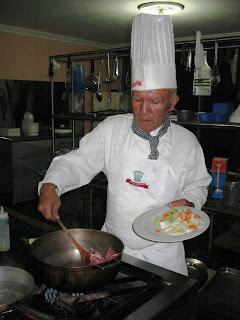
The English Teacher as Photographer
About now you're looking ahead to the upcoming semester break or end-of-year holiday vacation. If you're planning to travel around the country where you may be teaching abroad or at home, as a versatile EFL professional, an essential for any trip is your camera. Whether you plan to shoot digital, slide or print images, one question that likely pops up is, “What should I shoot?” If you’re on a semester break or vacation the answer is easy though your choices can be a bit more extensive. On the other hand, with some insight and planning, your photo options can be even greater. So essentially, you’re going to go for the new, unique and different that will surround you. Here are some suggested approach ideas.
Fashions
What are the locals wearing? What do you recommend visitors bring or wear?
Pay attention to men’s, women’s and children’s clothing. Don’t forget shoes and accessories. Are there specialty clothing items or accessories manufactured or worn locally? Intrigued by the dress code of Embera Indian women when they “came to town” on South America’s Pacific coast, I asked locals about their colorful wear. The photos, interviews and stories I got access to fuel numerous articles and short readings for my English as a foreign lñanguage classes to this day.
People and Occupations
Are the locals noticeably different from people where you are from? Photograph them at work. How do people get around? On foot, bikes, specialty vehicles? Catch vendors, artisans and tradesmen at work in their own surroundings. Be sure to ask permission first. If there are any occupations that are unusual or off-the-beaten track, get a variety of shots of them. Look for common jobs done in different or unique ways. Street hucksters can provide colorful photo opportunities as well as offer a slice of local ambience.
Everyday Life
How do people live in the locale? Get shots of people going about their daily lives. Stop and linger awhile at local playgrounds, parks and watering holes. Ask waiters and bartenders about the most popular brews, mixes and concoctions. Be sure to try a few yourself for a “first-hand” account.
About People Pictures
Want really good people shots? Just ask. Just smile and say, “Can I take a picture?” If you don’t speak the local language, smile and point to your camera. They’ll get it and smile back or nod permission. Ninety eight of the last 100 people I’ve asked to let me take their photo said, “Yes”. The two who didn’t? A military officer scolded me for taking a shot of a soldier walking on patrol along a picturesque Pacific coast beach. I showed him the digital frame noting that you couldn’t really tell it was a soldier and he relented. The other was an elderly Embera Indian man who was husking rice in his Colombian jungle village using a waist-high mortar and pestle. He wanted me to agree to give him some “gifts” in exchange for the shots. I didn’t, he wouldn’t.
Work two or three location slants
When you have two or three topic areas in mind, your eye will focus and photo ops will pop up all around you. The process can even begin before your trip and often continues during and after the time you are on location. Keep a spiral-bound notepad and pens on you at all times to note essentials like subject names, new vocabulary, unusual spellings, and telephone numbers. Jot down brief explanations of who, what, when, where, why and how to help jog your memory and correctly caption photos. Bear in mind that many editors require identification of subjects in photos.
So enjoy your trip this vacation or semester break, take notes as needed and shoot away. Once you leave the location, the photo ops are gone. My motto is, “When in doubt, take the shot.” It’s better to have it and not need it than to need it and not have it. Take that shot. Later, you might just be glad you did. An extensive variety of digital images has a plethora of uses in the EFL class room, so you shouldn't miss any opportunity to photograph "authentic" scenes and images for later use.
Want even more ideas? See you in part 2 of this series where we'll discuss some practical EFL class room uses for your digital photograhy.
See you then.
Prof. Larry M. Lynch is an EFL Teacher Trainer, Intellectual Development Specialist, prolific writer, author and public speaker. He has written ESP, foreign language learning, English language teaching texts and hundreds of articles used in more than 100 countries. Get your FREE E-book, "If you Want to Teach English Abroad, Here's What You Need to Know" by requesting the title at: lynchlarrym@gmail.com Need a blogger or copywriter to promote your school, institution, service or business or an experienced writer and vibrant SEO content for your website, blog or newsletter? Then E-mail me for further information.







No comments:
Post a Comment